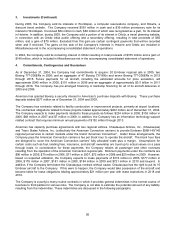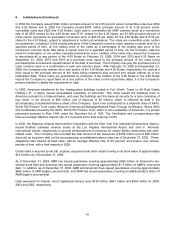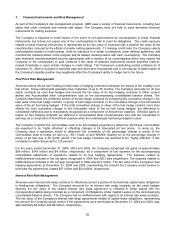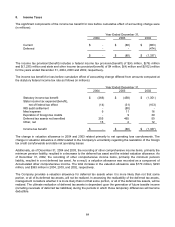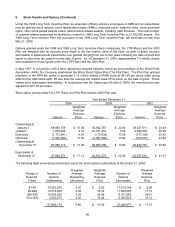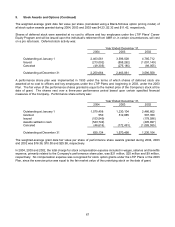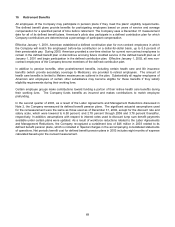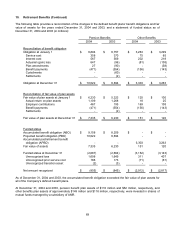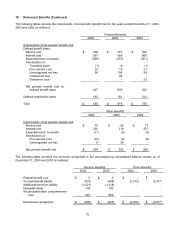American Airlines 2004 Annual Report Download - page 65
Download and view the complete annual report
Please find page 65 of the 2004 American Airlines annual report below. You can navigate through the pages in the report by either clicking on the pages listed below, or by using the keyword search tool below to find specific information within the annual report.62
7. Financial Instruments and Risk Management
As part of the Company's risk management program, AMR uses a variety of financial instruments, including fuel
option and collar contracts and interest rate swaps. The Company does not hold or issue derivative financial
instruments for trading purposes.
The Company is exposed to credit losses in the event of non-performance by counterparties to these financial
instruments, but it does not expect any of the counterparties to fail to meet its obligations. The credit exposure
related to these financial instruments is represented by the fair value of contracts with a positive fair value at the
reporting date, reduced by the effects of master netting agreements. To manage credit risks, the Company selects
counterparties based on credit ratings, limits its exposure to a single counterparty under defined guidelines, and
monitors the market position of the program and its relative market position with each counterparty. The Company
also maintains industry-standard security agreements with a number of its counterparties which may require the
Company or the counterparty to post collateral if the value of selected instruments exceed specified mark-to-
market thresholds or upon certain changes in credit ratings. The Company’s outstanding posted collateral as of
December 31, 2004 is included in restricted cash and short-term investments and is not material. A deterioration of
the Company’s liquidity position may negatively affect the Company’s ability to hedge fuel in the future.
Fuel Price Risk Management
American enters into jet fuel, heating oil and crude oil hedging contracts to dampen the impact of the volatility in jet
fuel prices. These instruments generally have maturities of up to 36 months. The Company accounts for its fuel
option contracts as cash flow hedges and records the fair value of its fuel hedging contracts in Other current
assets and Accumulated other comprehensive loss on the accompanying consolidated balance sheets. The
Company determines the ineffective portion of its fuel hedge contracts by comparing the cumulative change in the
total value of the fuel hedge contract, or group of fuel hedge contracts, to the cumulative change in the forecasted
value of the jet fuel being hedged. If the total cumulative change in value of the fuel hedge contract more than
offsets the total cumulative change in the forecasted value of the jet fuel being hedged, the difference is
considered ineffective and is immediately recognized as a component of Aircraft fuel expense. Effective gains or
losses on fuel hedging contracts are deferred in Accumulated other comprehensive loss and are recognized in
earnings as a component of Aircraft fuel expense when the underlying jet fuel being hedged is used.
The Company monitors the commodities used in its fuel hedging programs to determine that these commodities
are expected to be “highly effective” in offsetting changes in its forecasted jet fuel prices. In doing so, the
Company uses a regression model to determine the correlation of the percentage change in prices of the
commodities used to hedge jet fuel (e.g., WTI Crude oil and NYMEX Heating oil) to the percentage change in
prices of jet fuel over a 36 month period. The fuel hedge contracts are deemed to be “highly effective” if this
correlation is within 80 percent to 125 percent.
For the years ended December 31, 2004, 2003 and 2002, the Company recognized net gains of approximately
$99 million, $149 million and $4 million, respectively, as a component of fuel expense on the accompanying
consolidated statements of operations related to its fuel hedging agreements. The expense related to
ineffectiveness included in the net gains recognized in 2004 and 2003 was insignificant. The expense related to
ineffectiveness included in the net gain recognized in 2002 was $13 million. The fair value of the Company’s fuel
hedging agreements at December 31, 2004 and 2003, representing the amount the Company would receive to
terminate the agreements, totaled $51 million and $54 million, respectively.
Interest Rate Risk Management
American uses interest rate swap contracts to effectively convert a portion of its fixed-rate capital lease obligations
to floating-rate obligations. The Company accounts for its interest rate swap contracts as fair value hedges
whereby the fair value of the related interest rate swap agreement is reflected in Other assets with the
corresponding liability being recorded as a component of Obligations Under Capital Leases on the accompanying
consolidated balance sheets. The Company has no ineffectiveness with regard to its interest rate swap contracts.
The fair value of the Company’s interest rate swap agreements related to capital lease obligations, representing
the amount the Company would receive if the agreements were terminated at December 31, 2004 and 2003, was
approximately $4 million and $9 million, respectively.






